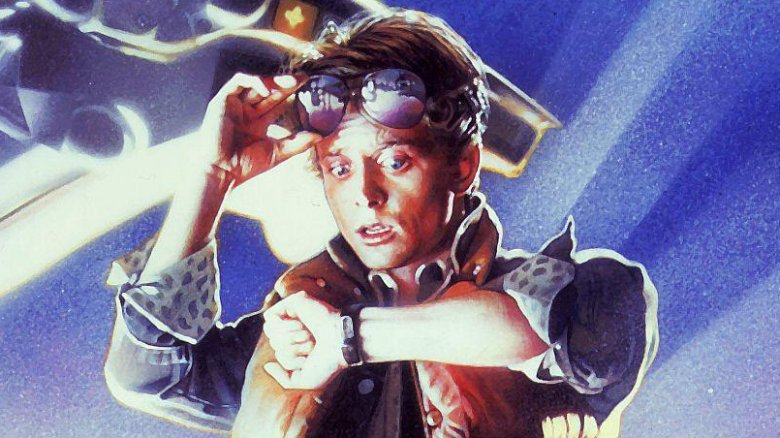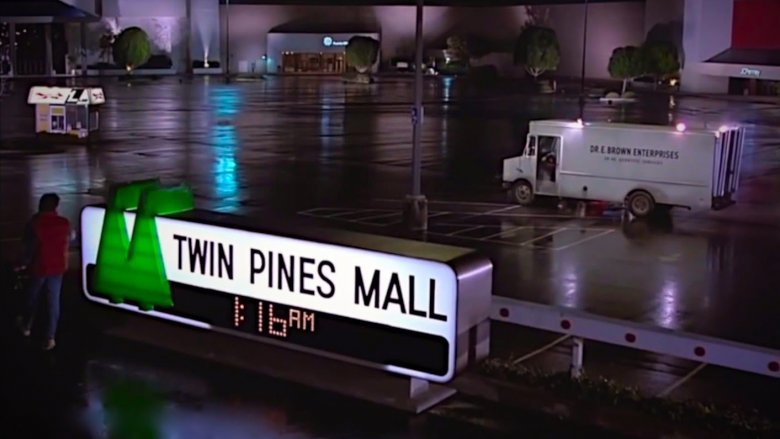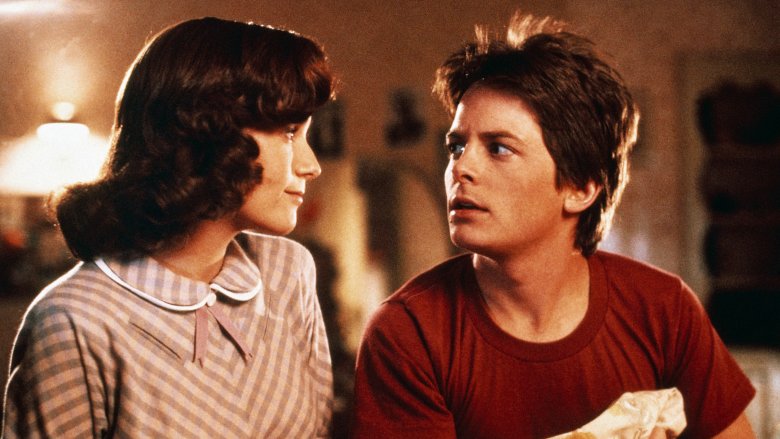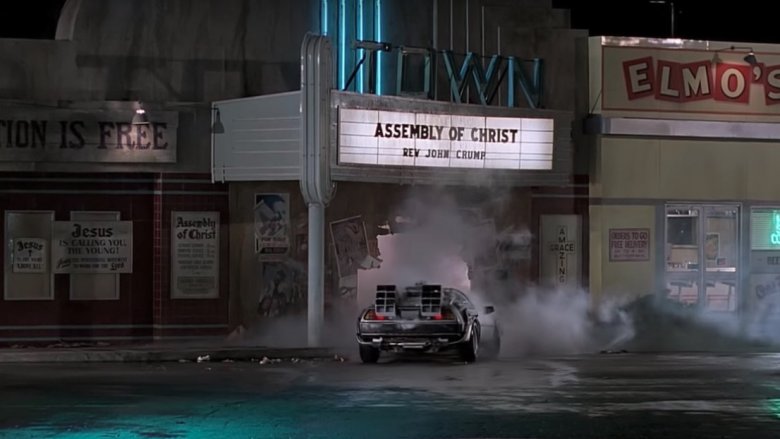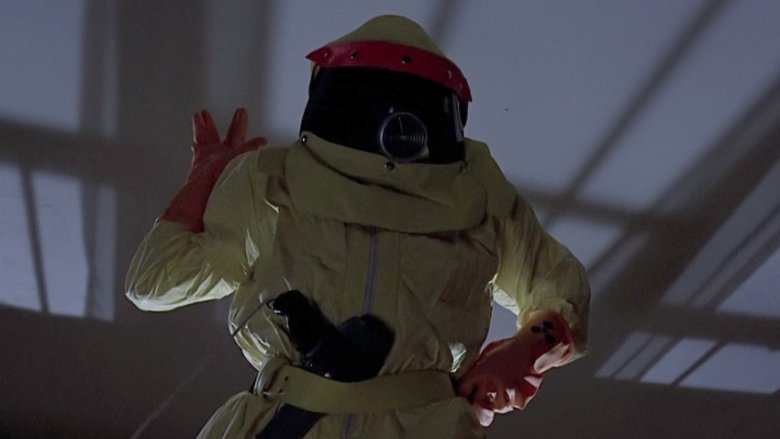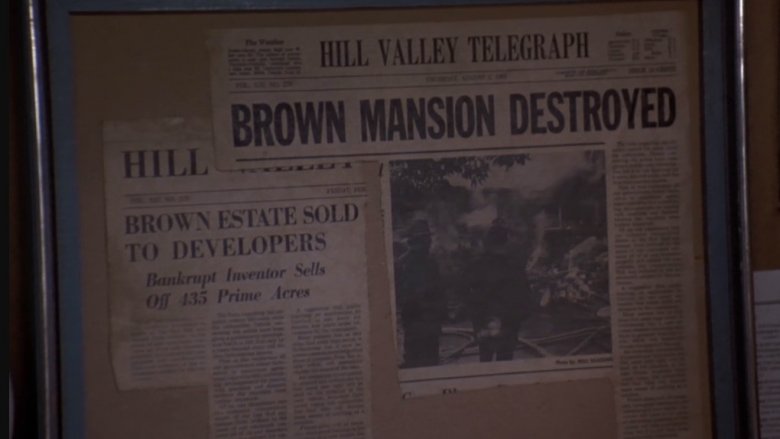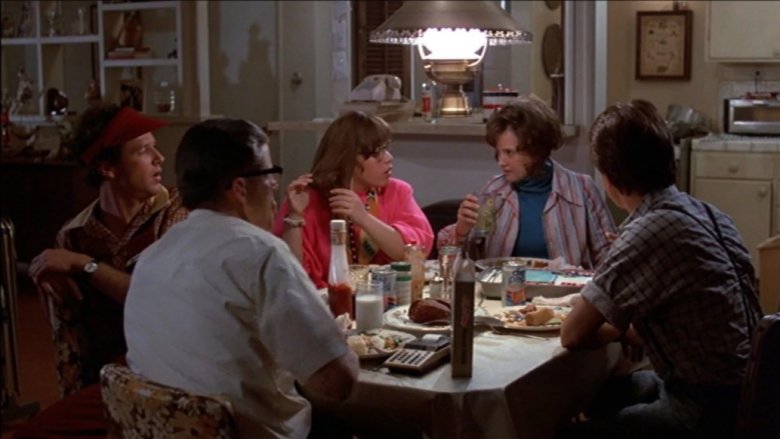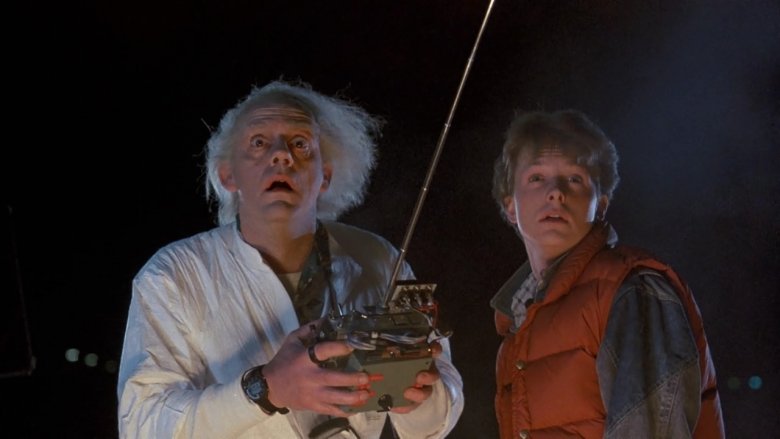Back To The Future Details That Only Adults Notice
Back to the Future isn't just a time-travel movie, it's also a timeless movie. Directed by Robert Zemeckis and produced by Steven Spielberg, the movie is an '80s classic, with incredible performances from Christopher Lloyd and Michael J. Fox and a nearly perfect script (written by Zemeckis and Bob Gale) that's packed with wit and charm. A smash hit in 1985, the movie spawned a franchise — not to mention limited edition sneakers, a lot of fake "Back to the Future Days" (and one real one), and a thirst for hoverboards that remains unquenched. The movie's so beloved, in fact, that its use of the failed DeLorean automobile was enough to cement the car as "cool" in popular culture for decades.
Still, while the movie remains a comfortable pleasure for many fans, there are a lot of clever moments and uncomfortable subtext in the original Back to the Future that flew right over your head if you watched it when you were a kid. From rock and roll nods to Freudian subplots, here are things that only adults notice in Back to the Future.
Mister Peabody and Sherman
The emotional core of Back to the Future is without a doubt Marty McFly and Doc Brown's unshakable friendship. Marty is impulsive and questioning while Doc remains cautious and knowledgeable, and their back-and-forth banter drives the plot of the film. The pairing of a wise mentor and his rebellious student goes back through popular culture for centuries (arguably even millennia), and there are plenty of examples that adults watching Back to the Future might be familiar with. Most pertinent, though, are Mister Peabody and Sherman, the cartoon stars of the Peabody's Improbable History shorts from Rocky and Bullwinkle.
The cartoons followed a young boy and his hyper-intelligent dog as they traveled through history to learn facts about the world. While the two pairs aren't exactly identical to each other, Zemeckis and Gale paid homage to these earlier time travelers with a subtle gag alert viewers will notice when Marty crashes into a farmhouse owned by the Peabody family. In fact, the little boy who assumes Marty to be an alien is even named Sherman (although he's only named in the credits). While it might seem like a winking reference, is it actually proof that Einstein, Doc Brown's lovable dog, is the real brains behind the time machine just like Mr. Peabody? Probably not, but it's a fun Easter egg regardless.
Now entering the mall of Twin Pines
One of the most engrossing things about Back to the Future is the way the movie shows the consequences of Marty's meddling with time: nearly everything set up in the first 15 minutes of the movie is paid off once Marty goes back in time. There are the obvious things, like Marty being a musician so he can fill in for the Starlighters lead guitarist, or the clock tower restoration society giving Marty the idea of when lightning will strike, but there's a more subtle — but no less fun — reference that's paid off by the end of the film.
Marty meets Doc to see the time machine at Twin Pines Mall. When Marty goes back in time, one of the first things he does is knock over a pine tree. It's not openly commented on in the film, but once he gets back to the future, the name of the shopping center has been changed to Lone Pine Mall. It's a fun bit of foreshadowing for the larger changes that Marty's made to the timestream that neither he nor the audience are aware of yet, but it does beg the question: what kind of maniac only plants two pine trees in a field?
Marty McFreud
One of the most appealing parts of the movie, especially to children, is Marty getting to meet his parents when they were his age. Instead of the authority figures whose decision-making is inscrutable, Marty's parents in 1955 are his peers. Seeing them at that age humanizes them, and serves as a reminder to youthful audiences that your parents were young once too.
Less wholesome — particularly for adults who notice the incestuous subtext — are the extremely uncomfortable scenes in which Marty's mother tries to seduce him after her father (Marty's grandfather) hits him with a car. There's a Freudian discomfort to Marty having to fend off his mother's romantic advances in order to encourage her to go to prom with his own father. In fact, one could interpret the whole movie through the lens of Dr. Freud's Oedipus Complex theory — Marty even "kills" his father's spinelessness by threatening him with the space invader disguise. Of course, the psychological interpretation of the film doesn't make it any less gross when Lorraine kisses Marty and says "This is all wrong. I don't know what it is. But when I kiss you, it's like I'm kissing... my brother." Lorraine, we couldn't agree more.
Marty B. Goode (at playing guitar)
Back to the Future is great for a lot of reasons, but the climactic musical performance that Marty puts on at the prom is a highlight in a whole movie of highlights. Like many moments in the movie, it brings character beats and off-hand lines full circle as Marty finally gets to play on stage in front of his whole high school (about 30 years earlier than he hoped) while assuring that his parents get together...and that he gets to keep existing. It's a great scene, but it's also packed to the brim with musical references.
Most fans got the joke that Chuck Berry's cousin calls him to let him know about "Johnny B. Goode," but Marty is emulating more than a tune while he plays. His performance features Chuck Berry's famous "duckwalk," fretboard taps like Eddie Van Halen, sees him playing guitar behind his head like Jimi Hendrix, and sliding across the floor like Angus Young. The musical touchstones were apparently a personal touch contributed by Michael J. Fox, since the script originally called for references to "Little Richard, Elvis, Mick Jagger and Michael Jackson" instead.
Cinema, a dying art form in Hill Valley
Thirty years is a lot of time for things to change in Hill Valley, which is part of the fun of Back to the Future. Audiences see Marty encourage the future mayor to run for office in 1955, save Doc from being shot to death, and accidentally change the name of the Twin Pines Mall. But one excellent detail that showcases the difference between 1955 and 1985 has nothing to do with Marty: the rise and fall of the Essex Theater.
The Essex Theater appears in 1955 Hill Valley advertising a screening of Cattle Queen of Montana, a movie starring Ronald Reagan. The particular choice of Cattle Queen of Montana mostly exists to reinforce Doc Brown's disbelief that Ronald Reagan is the president in 1985, but there's another Easter egg in the theater that you might notice earlier. In 1985, attentive audiences might notice that the Essex Theater (now run down) has a marquee advertising a much more adult movie than Cattle Queen of Montana. Hill Valley doesn't exactly seem to have a thriving cinema scene in 1985, as the Town Theater has turned into an Assembly of Christ meeting place — a far cry from its 1955 showing of The Atomic Kid. With no place to see a regular movie, there's no wonder that Marty befriended a kooky inventor.
I come from planet Vulcan!
Marty really gets put through the wringer trying to get his parents to hook up after he accidentally interrupts their meet cute in 1955. One of the most inventive tricks he pulls is to pretend to be an alien and threaten George with death if he doesn't ask Lorraine out. Marty knows that George is a bit of a science fiction geek, so it's surprisingly effective at convincing George, even if it doesn't quite go as Marty planned. The catch is that Marty announces his fake alien persona to George as "Darth Vader" from "Planet Vulcan." By the end of the movie, George has even written a novel that, based on the cover design, is at least partly inspired by the meeting.
The one strange part is that George is going to find terms like "Darth Vader" and "Planet Vulcan" very familiar once Star Wars and Star Trek are made. What must George have thought when he noticed those words for the first time as part of a science fiction movie or show? Considering he's written his own novel by 1985, it's not unlikely to assume that George thinks both George Lucas and Gene Roddenberry were visited by that same "alien" that inspired their own works. It's pretty easy to imagine adult George attending sci-fi conventions trying to snag a few precious seconds with Lucas and Roddenberry to confirm they had the same close encounter he once experienced.
We didn't start the fire, but Doc Brown did
Speaking of Doc's address, savvy adults watching the movie will notice that when Marty gets to Doc's house in 1955, it's a much more impressive structure than audiences see in the opening scene of the movie in 1985 — what ended up being Doc's home was actually his garage 30 years before. Attentive audience members might have already noticed that a framed newspaper clipping in the opening scene bears the headline "Brown Mansion Destroyed" and the accompanying sub-headline "Brown Estate Sold To Developers." It seems like Doc moved into his garage after his mansion was tragically destroyed some time after 1955.
However, the newspaper clipping getting framed in Doc's garage-turned-home has always seemed strange, and it turns out there's a reason for that. According to screenwriter Bob Gale in the Blu-ray commentary for the film, "You can infer from that that maybe Doc set his house on fire to collect the insurance money." While that detail explains how Doc was able to spend so much of his life working on a time machine without a real job, that's a very dark explanation for our favorite crazy inventor's disposable income. Gale would later retcon that explanation in a comic continuation of the movie by explaining the fire as the only solution to further timeline mishaps. Still, as far as the movie is concerned, Doc Brown sure seems like he committed insurance fraud. Great Scott!
This is not Marty's beautiful house, this is not Marty's beautiful family
Speaking of dark plot points in the original Back to the Future, the ending of the film is much darker than it seems at first glance. By the end of the film, Marty's gotten the truck of his dreams, his brother is wearing a suit to work instead of slacking off at home, and his mom and dad seem both happier and more supportive of Marty's decisions. George even published a book, even though it looks about as thick as Infinite Jest. The audience is as surprised as Marty is to find that his week of time-travel shenanigans affected the future so much, especially since Marty has strong memories of what his family used to be like before he went back to the present.
Still, the supposedly happy ending becomes existentially horrifying when you remember that Marty doesn't really know these people. They look like his family and act like an improved version of his family, but they reference moments that leave Marty baffled and confused when he compares them to the people he left just yesterday in 1985. Imagine having an entire life that's similar, but decidedly different, from the one you remember happening. Imagine sitting down with your family as they make reference to events from your childhood that are just close enough to leave you with deja vu but not enough to spur any actual memories of the event in question. Marty's old family, with all their problems and personality flaws, might as well be dead, replaced by go-getters and positive thinkers.
Time travel paradox solved
Using time travel in science fiction stories is famously difficult to do, especially considering that physicists still can't agree on whether it's actually possible in the first place. At a certain point in sci-fi, if your science gets in the way of your fiction, then it's not exactly good science fiction. One of the many reasons that Back to the Future holds up is that it doesn't dwell on the scientific details, or why some paradoxes in the movie happen instantly while others take longer. The movie leaves it up to the dramatic needs of the film, and it's better for it.
But just because the film doesn't explain how it's possible doesn't mean that fans haven't taken it upon themselves to offer their own theories. Comics writer Ryan North annotated the Back to the Future novelization and broke down exactly how much "meta-time" the changes in the timeline take to effect the events audiences see onscreen. North explains that "changes to the timeline THEMSELVES take time... A change made to the timeline on November 5th, 1955 takes 7 days of real time to ripple through time and reach June 9th, 1968." North goes on to clarify that Marty's immediate recovery after getting George and Lorraine back together can be explained by assuming that "the timeline is flexible, but like a spring, it has a preferred shape... Changes that restore it to its original form propagate much faster." All in all, it's a surprisingly convincing theory that explains how even the more dramatic timeline changes are eminently reasonable. Doc Brown would be proud.
